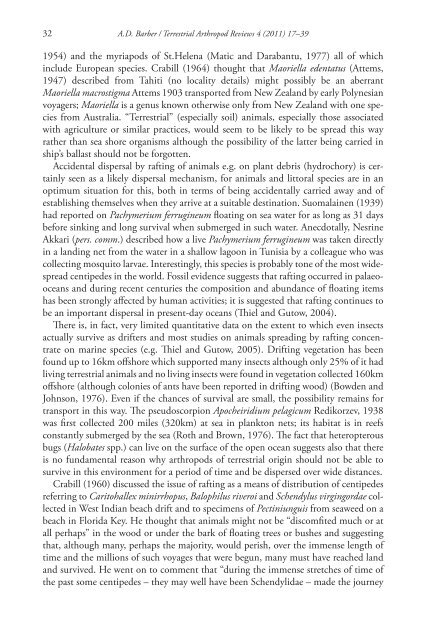Geophilomorph centipedes and the littoral habitat - Books and ...
Geophilomorph centipedes and the littoral habitat - Books and ...
Geophilomorph centipedes and the littoral habitat - Books and ...
You also want an ePaper? Increase the reach of your titles
YUMPU automatically turns print PDFs into web optimized ePapers that Google loves.
32 A.D. Barber / Terrestrial Arthropod Reviews 4 (2011) 17–39<br />
1954 ) <strong>and</strong> <strong>the</strong> myriapods of St.Helena (Matic <strong>and</strong> Darabantu, 1977 ) all of which<br />
include European species. Crabill ( 1964 ) thought that Maoriella edentatus (Attems,<br />
1947) described from Tahiti (no locality details) might possibly be an aberrant<br />
Maoriella macrostigma Attems 1903 transported from New Zeal<strong>and</strong> by early Polynesian<br />
voyagers; Maoriella is a genus known o<strong>the</strong>rwise only from New Zeal<strong>and</strong> with one species<br />
from Australia. “Terrestrial” (especially soil) animals, especially those associated<br />
with agriculture or similar practices, would seem to be likely to be spread this way<br />
ra<strong>the</strong>r than sea shore organisms although <strong>the</strong> possibility of <strong>the</strong> latter being carried in<br />
ship’s ballast should not be forgotten.<br />
Accidental dispersal by rafting of animals e.g. on plant debris (hydrochory) is certainly<br />
seen as a likely dispersal mechanism, for animals <strong>and</strong> <strong>littoral</strong> species are in an<br />
optimum situation for this, both in terms of being accidentally carried away <strong>and</strong> of<br />
establishing <strong>the</strong>mselves when <strong>the</strong>y arrive at a suitable destination. Suomalainen ( 1939 )<br />
had reported on Pachymerium ferrugineum fl oating on sea water for as long as 31 days<br />
before sinking <strong>and</strong> long survival when submerged in such water. Anecdotally, Nesrine<br />
Akkari ( pers. comm .) described how a live Pachymerium ferrugineum was taken directly<br />
in a l<strong>and</strong>ing net from <strong>the</strong> water in a shallow lagoon in Tunisia by a colleague who was<br />
collecting mosquito larvae. Interestingly, this species is probably tone of <strong>the</strong> most widespread<br />
<strong>centipedes</strong> in <strong>the</strong> world. Fossil evidence suggests that rafting occurred in palaeooceans<br />
<strong>and</strong> during recent centuries <strong>the</strong> composition <strong>and</strong> abundance of fl oating items<br />
has been strongly aff ected by human activities; it is suggested that rafting continues to<br />
be an important dispersal in present-day oceans (Th iel <strong>and</strong> Gutow, 2004 ).<br />
Th ere is, in fact, very limited quantitative data on <strong>the</strong> extent to which even insects<br />
actually survive as drifters <strong>and</strong> most studies on animals spreading by rafting concentrate<br />
on marine species (e.g. Th iel <strong>and</strong> Gutow, 2005 ). Drifting vegetation has been<br />
found up to 16km off shore which supported many insects although only 25% of it had<br />
living terrestrial animals <strong>and</strong> no living insects were found in vegetation collected 160km<br />
off shore (although colonies of ants have been reported in drifting wood) (Bowden <strong>and</strong><br />
Johnson, 1976 ). Even if <strong>the</strong> chances of survival are small, <strong>the</strong> possibility remains for<br />
transport in this way. Th e pseudoscorpion Apocheiridium pelagicum Redikorzev, 1938<br />
was fi rst collected 200 miles (320km) at sea in plankton nets; its <strong>habitat</strong> is in reefs<br />
constantly submerged by <strong>the</strong> sea (Roth <strong>and</strong> Brown, 1976 ). Th e fact that heteropterous<br />
bugs ( Halobates spp.) can live on <strong>the</strong> surface of <strong>the</strong> open ocean suggests also that <strong>the</strong>re<br />
is no fundamental reason why arthropods of terrestrial origin should not be able to<br />
survive in this environment for a period of time <strong>and</strong> be dispersed over wide distances.<br />
Crabill ( 1960 ) discussed <strong>the</strong> issue of rafting as a means of distribution of <strong>centipedes</strong><br />
referring to Caritohallex minirrhopus , Balophilus riveroi <strong>and</strong> Schendylus virgingordae collected<br />
in West Indian beach drift <strong>and</strong> to specimens of Pectiniunguis from seaweed on a<br />
beach in Florida Key. He thought that animals might not be “discomfi ted much or at<br />
all perhaps” in <strong>the</strong> wood or under <strong>the</strong> bark of fl oating trees or bushes <strong>and</strong> suggesting<br />
that, although many, perhaps <strong>the</strong> majority, would perish, over <strong>the</strong> immense length of<br />
time <strong>and</strong> <strong>the</strong> millions of such voyages that were begun, many must have reached l<strong>and</strong><br />
<strong>and</strong> survived. He went on to comment that “during <strong>the</strong> immense stretches of time of<br />
<strong>the</strong> past some <strong>centipedes</strong> – <strong>the</strong>y may well have been Schendylidae – made <strong>the</strong> journey









![Am HaSefer [Volk des Buches] - Books and Journals](https://img.yumpu.com/20648352/1/174x260/am-hasefer-volk-des-buches-books-and-journals.jpg?quality=85)







